Wednesday 5th December - Ray Baker
I walked around the reserve today and, other than a single male Bullfinch feeding on the berries down by the pond, and the now regular hordes of Blackbirds, there wasn't a great deal to be seen, so I thought I'd tell you about some things that I didn't see - well, to be more precise, one that I didn't see at all, and one that I saw, but only outside of the reserve.
The main purpose of my visit was to search for Waxwings..... You may have read about these in the press, since we are in the midst of one of the periodic invasions of this species into the UK, and there are large numbers of them currently in the area - some having been reported in East Grinstead and also Shirley. They are very showy (see photo!) and will usually be seen in flocks where they will lay claim to any tree or bush that still has berries on it - returning time after time until all of the berries are gone and they resume their search elsewhere. It is worth checking any berries in your garden or the local area, since Waxwings will often go where other birds fear to tread, with things like ornamental Cotoneaster bushes in supermarket car-parks being a particular favourite.
They are easy to identify if seen close-up, but when flying around and resting on aerials and tall trees, they look quite a bit like Starlings - so eyes peeled!
The thing that I DID see, albeit outside of the reserve, was a Ruddy Duck. Now this is a bird with an interesting story here in the UK....
For a start, it is not native to the UK (originating in the US I think!) but the offspring of escapes from private collections in the 1950s managed to do so well as to establish independent, viable breeding populations here in the UK, to the extent where it was accepted onto the British list (as a sidebar.... you might think that the list of British birds is a fairly static thing - it isn't, with new species being accepted or deleted all the time, and species being split into sub-species etc etc)
Anyway.... so far so good for the Ruddy Duck, until its expansion reached southern Europe, which is the stronghold for a similar species called the White-headed Duck... so similar, in fact, that the 2 species were able to interbreed and create hybrids (another quite common scenario in the wacky world of ducks!) This obviously created quite a bad situation, as regards the gene-pool of the threatened White-headed Duck, and after much debate, a cull of all of the Ruddy Ducks was agreed, and this happened about 3-4 years ago.
Much to my surprise at least, this cull proved to be very effective and within a year or two, the once quite common Ruddy Duck had virtually disappeared from around here... Except the one that I found, hiding out in a secret location not far from here!! It was a lone male though, so unlikely to kick off the return of the Ruddy Duck to the UK.
Waxwing Ruddy Duck
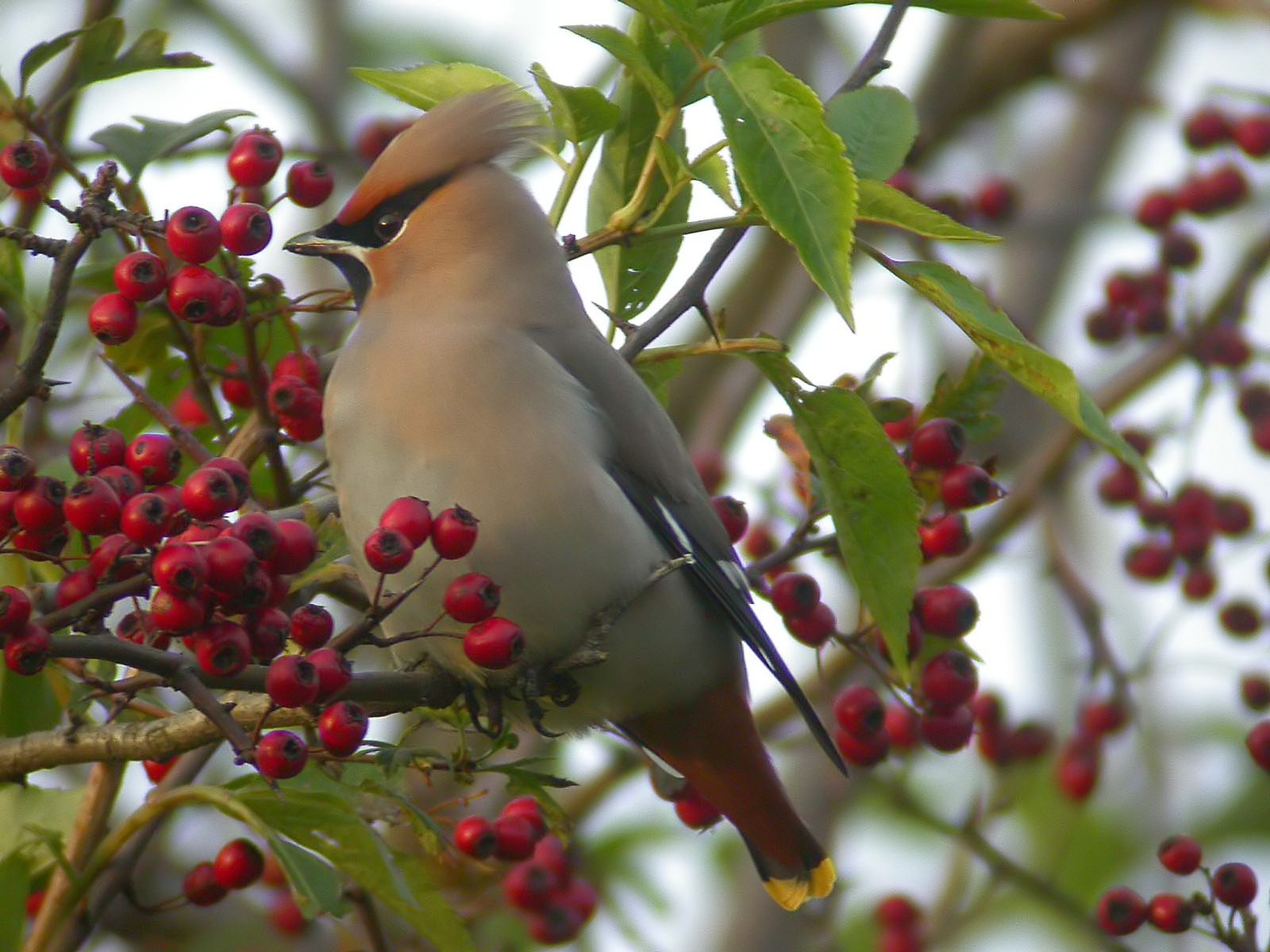
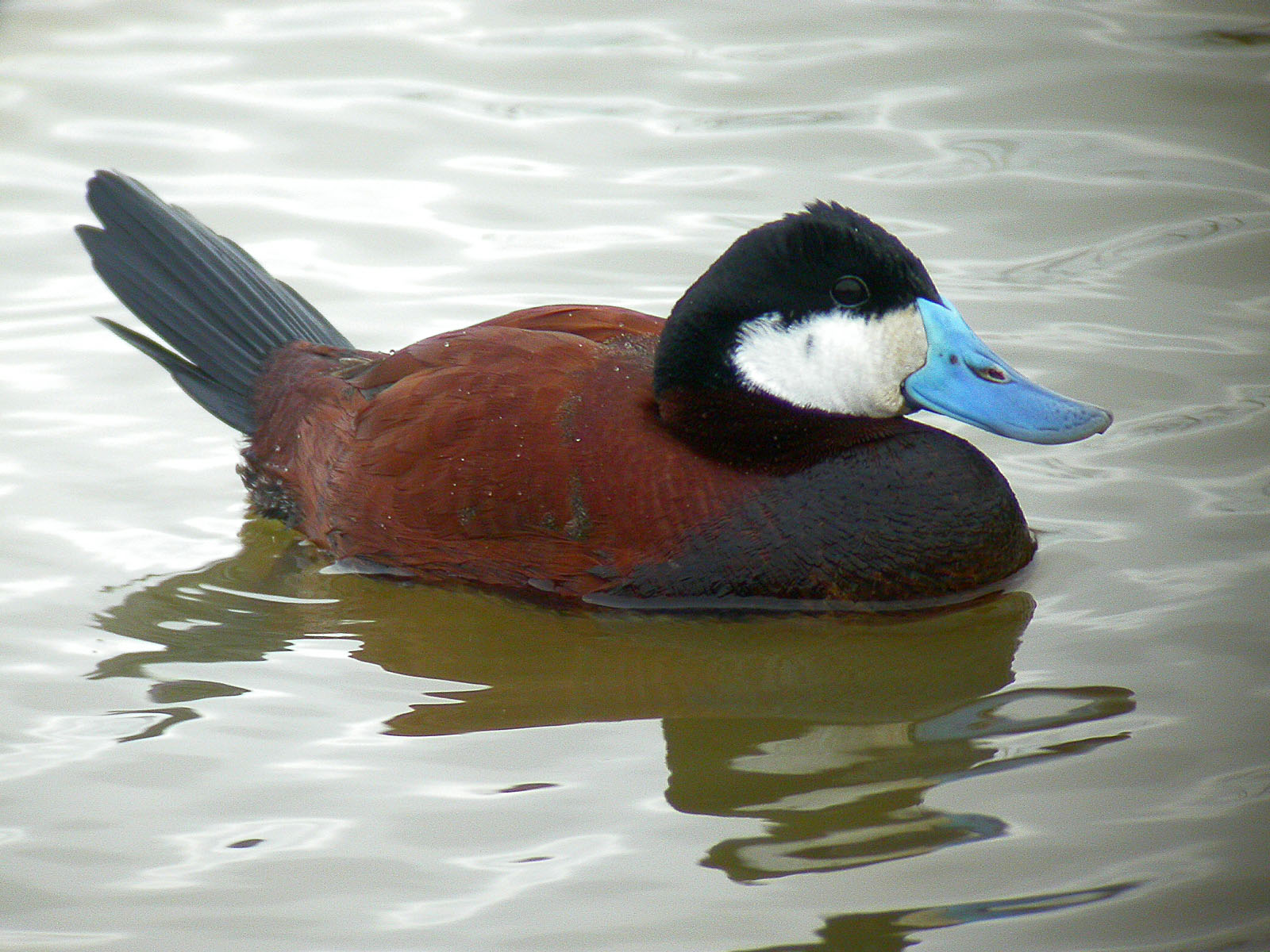
Saturday 1st December - Ray Baker
Entering the reserve from the orchard entrance, first thing that I noticed were the number of thrushes around - these would have been brought in by the cold snap of the last couple of days - and there were 5-6 Blackbirds feeding in the orchard, plus 2 Song Thrushes, with the fallen leaves under the fruit trees being the favoured spot for hunting for invertebrates. It was quite interesting actually, as there were very few birds down at the lower part of the reserve - in Coldharbour Copse for example - and I assume this to be because the still conditions had led to some thermal inversion and the lower parts had become a bit of a frost-hollow, hence less insects, hence less thrushes!
The 2 large oaks on the reserve boundary in the orchard continue to be something of a mecca for small birds, although today it was mainly tits and Nuthatches and I didn't see either Treecreepers or Goldcrests, but I only stood and looked for a couple of 5-minute spells, so could easily have just missed them.
There was a very handsome male Bullfinch feeding down in the hedge between Beacon and Bloomer's fields, and (as always seems to be the case these days) lots of larger birds about, with Jays, Crows, Magpies and Jackdaws all being conspicuous, plus noisy flocks of House Sparrows and Starlings down by the pond, plus the now regular Greenfinches.
I knew that today would be a good day as soon as I looked out into my garden and saw 5 Blackbirds on my (postage-stamp-sized!) lawn, squabbling over the remains of some apples that I had put out yesterday, and also I think I have now got 'my' resident Song Thrush for the winter, as I have seen one many times feeding in the shrubbery over the last week or so. If you are inclined to feed the thrushes, best bet is to cut your apples up into pieces and scatter them widely. These species are extremely possessive of food sources and it is therefore a bit counter-productive to just put out one or 2 whole apples, as the birds will use all of their energy fighting over them.
I had a quick look round most of the newly-planted trees and shrubs, and all seemed well, plus I also noticed that some of the bulbs we planted have started to show through too.
Greenfinch Jackdaw
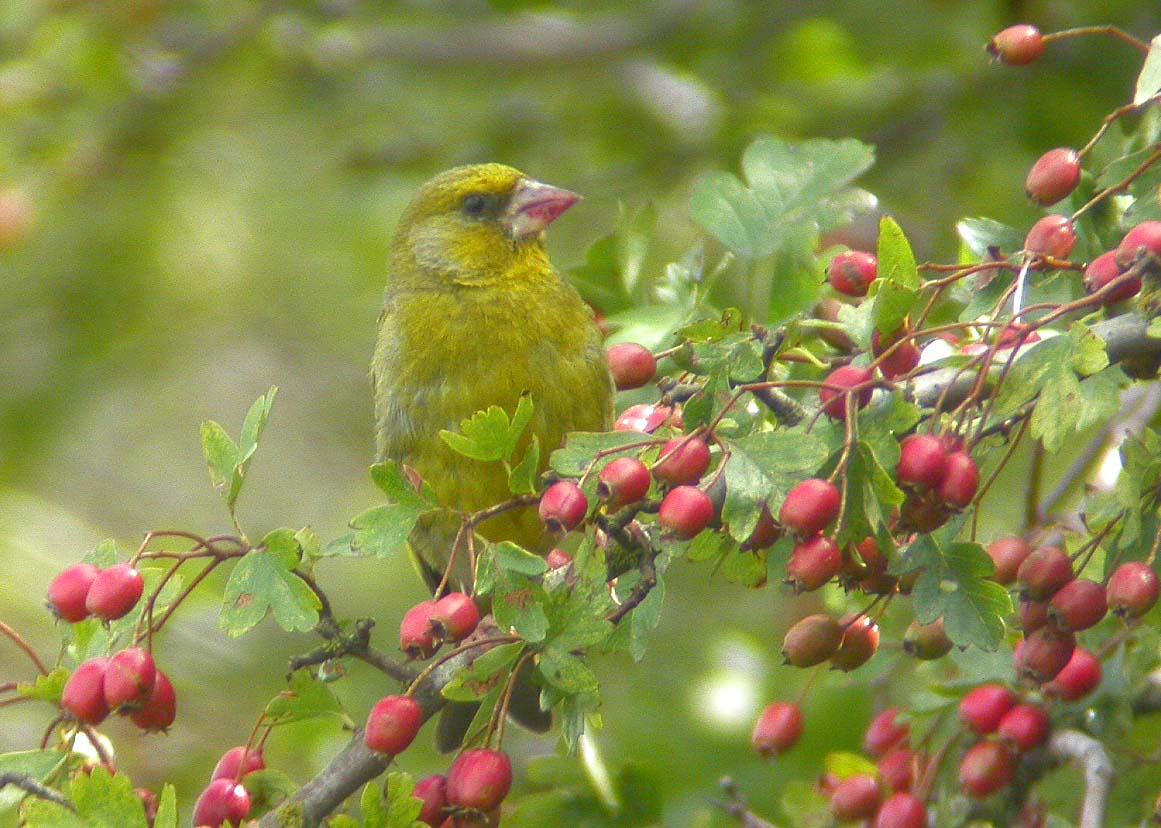
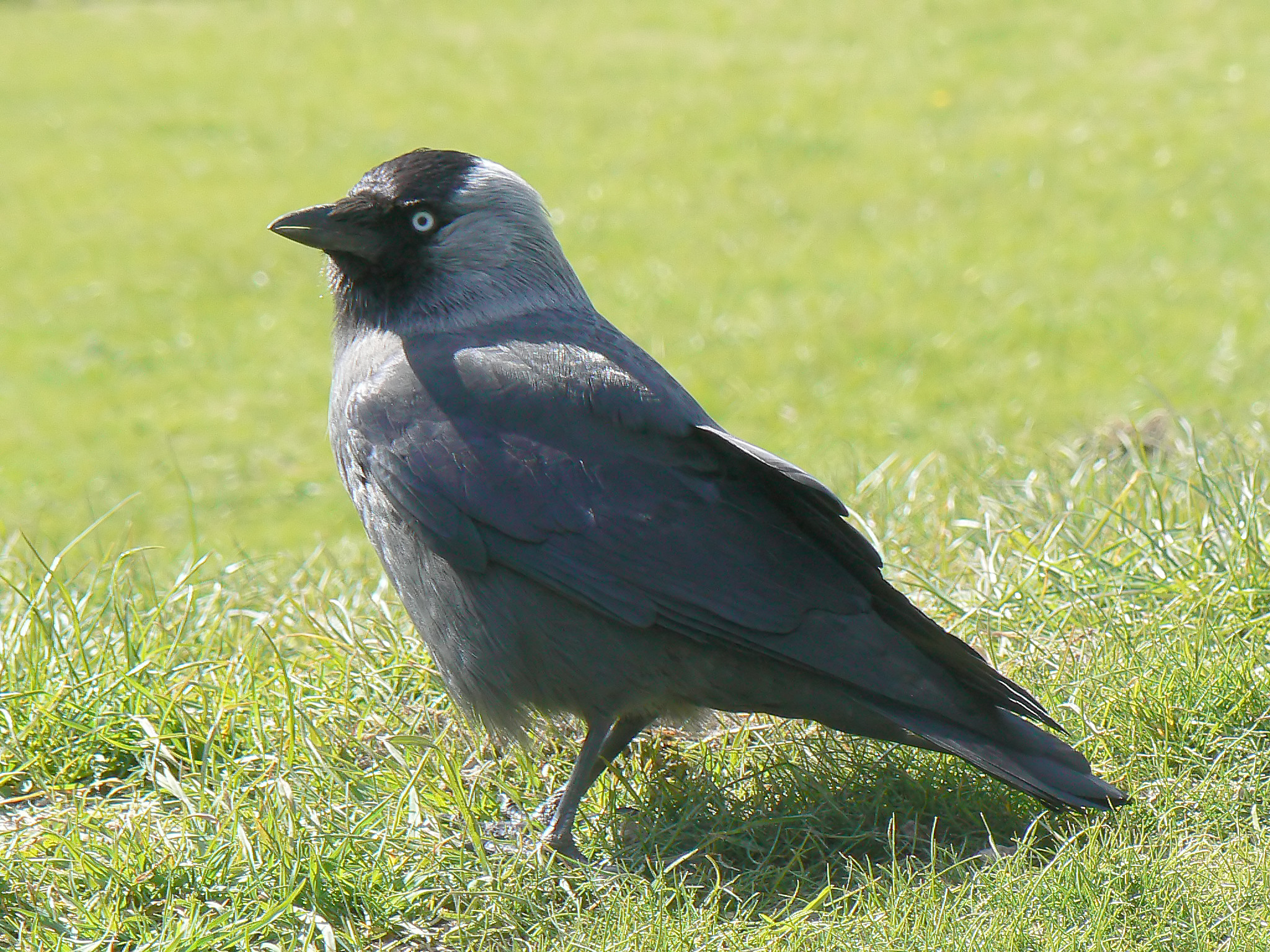
Friday 23rd November - Ray Baker
Had a quick walk around the reserve at lunchtime today and was struck by the amount of bird-activity in the 'treecreeper' oak tree in the orchard. There were quite a few Blue and Great Tits, a couple of Nuthatches and a number of Goldcrests - it's difficult to tell exactly how many, as it is all too easy to lose track of bird #1, when you are trying to track down bird #2! I would guess at 3 or maybe 4, and I checked them assiduously in the hope of finding our first ever Lingfield Firecrest, but no joy.
Quite a few Blackbirds and a single Redwing sitting on top of one of the tall oak trees, but again I couldn't see any Song Thrushes.
I was saying about seeing a Greenfinch last week, and this time there was 3 of them - again in the area down by the pond and in the gardens between there and the bottom corner of Jenner's Field. There must be a little colony around that area somewhere, as that is where I was mainly seeing them last spring.
There were 3 Goldfinches and 2 Redpolls feeding together in the allders by Derek Slade spinney and moving into the pond enclosure where they joined up with quite a large flock of House Sparrows that were feeding along the hedge. There was also quite a sizable flock of Starlings in the gardens and roofs of the houses.
In nearby news, I had my first Siskin of the winter on my feeder today, and I also thought I saw a male Blackcap. Unfortunately, it was awful views of this latter species, and it had gone by the time I got back with my BINs, so I'll just be keeping an eye out over the next few days to see if it returns. I have never seen an over-wintering Blackcap since moving to Lingfield, but they used to be regular every year in my old house, and I did notice that the males tended to never stick around whereas the females would sometimes stay for virtually the whole winter, so not holding out any great hopes for this one to show itself again.
Wednesday 14th November - Ray Baker
I was carrying out one of my winter thrush surveys for the BTO this morning, and the route for this particular survey takes in the reserve, so I ended up walking through....
Upon entering the orchard from the Headland Way entrance, first good bird that I saw was one of the Treecreepers that had presumably used one of our nestboxes nearby. I didn't get much more than a very fleeting glimpse at first, and I was trying to analyze what it was that enabled me to identify it as being a Treecreeper with so little data to go on, and came to the conclusion that it is probably because this species flash quite a lot of white when they fly from tree-to-tree. The more usual view is when they are creeping, mouse-like up a tree trunk, and then their cryptic mantle plumage merges in to the bark very well, but in flight the white chest and belly show up quite well, and are a good differentiator to other species, such as tits, crests and Nuthatches that might be flying in a similar fashion.
Anyway, I tracked this one down and eventually got very close views to confirm my suspicions as to what it was.
There was a very close Green Woodpecker in the orchard which flushed straight away as I entered.
When down by the pond, there was a male Greenfinch feeding on the path. This was a conicidence, as I had been mulling over a few species that I haven't been seeing much of recently, and Greenfinch was on the list! As I have written previously, this species was very badly hit by the trichomoniasis parasite, but I saw quite a few birds this spring-time, and had been wondering if they were showing signs of recovery. Of course, as Sod's Law would have it, other than 1 or 2 sightings on my feeders, I haven't seen a Greenfinch since (until today!) so my optimism was a little misplaced.
There were a few good birds seen close to the reserve, with best one probably being a Grey Wagtail which was feeding on some damp ground just by the sheepfields - it's a shame that it couldn't just venture a few hundred metres over, as this would be a new bird species for the reserve.
I sometimes think that the guy who gave the English names to the wagtail species must have been having a bad day, since the Grey Wagtail is actually rather yellow, although not as yellow as the Yellow Wagtail, which is really yellow. You shouldn't confuse the Grey Wagtail with the wagtail which is actually grey, because that is the Pied Wagtail, unless of course you are lucky enough to see the other pied wagtail which we sometimes get over from the near continent, which is the White Wagtail. All perfectly clear I hope!
Talking of wagtails, we are lucky enough to host a night-time roost of Pied Wagtails in Lingfield, and if you are passing by the area around the community centre at dusk in the winter, you will often see large numbers of birds starting to gather on the roofs, with The Place to Meet, and the curry shop opposite being particular favourites. The theory goes that wagtails gather in urban areas is to take advantage of residual heat around buildings and streetlights etc, but I'm not sure that anyone really knows for sure, as you might think that other species would follow suit if that were the case. For whatever reason, wagtails like to do it anyway - there is another large roost around the leisure centre and Morrison's in Oxted.
Thrush numbers continue to build, today I counted 11 Blackbirds, as well as Fieldfare, Redwing and Mistle Thrush, so it was a good morning.
Grey Wagtail Pied Wagtail
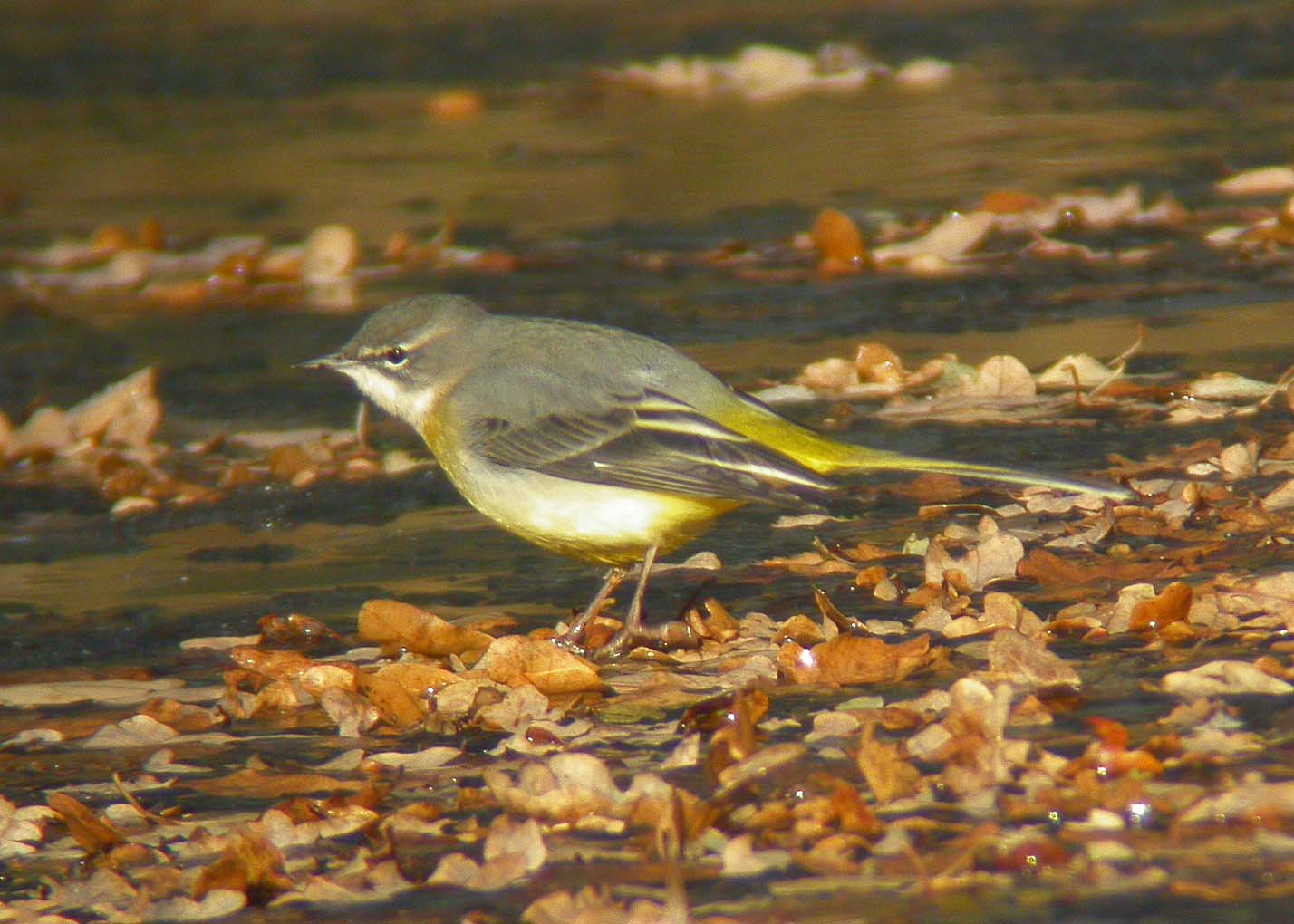
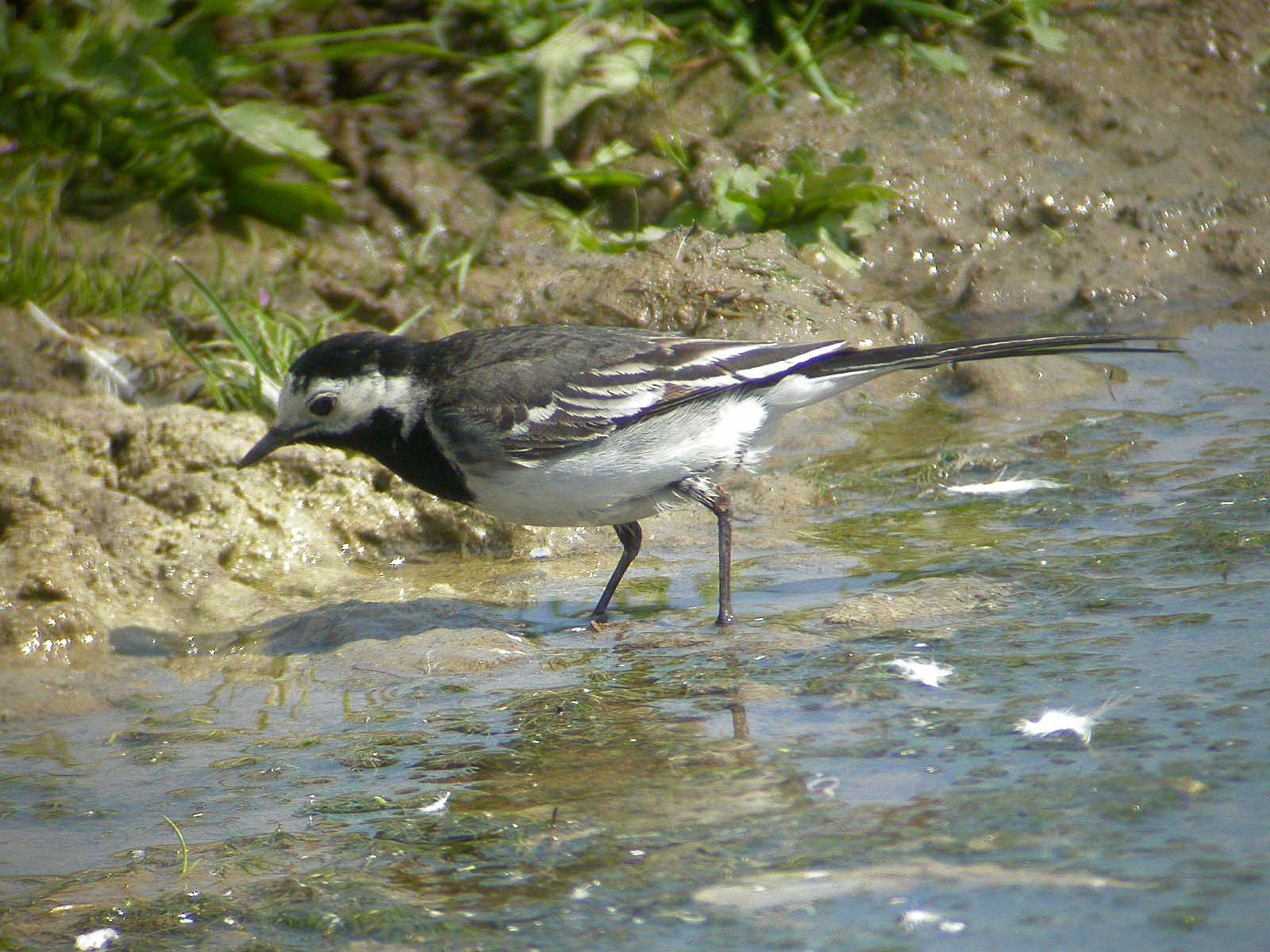
Friday 9th November - Ray Baker
Popped over to the reserve (with ladder!) this morning, as I am intrigued as to what species of mouse has taken up residence in the Nuthatch nestbox. This time, I was armed with my camera, but as soon as I opened the top of the box, a mouse exited via the entrance hole, seemingly having no qualms at all about facing the 5m or so drop to the ground! As before, it paused for a minute and then scurried off and was lost to sight amongst the leaves and brambles that are close to the tree trunk.
There was, however, a second mouse in the box, and as before, this one was not inclined to leave although clearly slightly agitated as it buried itself in amongst the bark chippings and leaves that had formed the original Nuthatch nest. I was able to get some looks at it though, so am able to confirm 100% that it isn't a Dormouse, as it had a bald, rather than hairy tail, so the remaining possibilities are probably Wood Mouse or Yellow-necked Mouse, and of these two, I would tend towards the latter, as they did appear to be a more golden-brown colour, than the slightly darker Wood Mouse.
Photography was pretty tricky, as I tried to cling to the ladder and snap an unco-operative subject, but there is a photo attached, so anyone familiar with mice is very welcome to draw their own conclusions! What you CAN see though, is the bark nesting materials, and the efforts that the birds have made to adjust the entrance hole with mud - both characteristic signs of Nuthatch being the use of this particular box.
I have walked around the reserve a couple of times this week, but not much to report really.... In the wider countryside though, I had some Long-tailed Tits on my feeder the other day and one of them was feeding on sunflower seeds in a way that I have never seen before..... It would take a seed in one claw and hang upside-down from a twig using just the other claw, whilst bringing the seed up to its bill to be munched on - seemed a very odd way to be going about things!
I also saw a couple of Redpolls feeding on weed seeds over by the showground, and will attach a photo - it's not a very good one, but is typical of the views that you are likely to get of this species and does show all the salient features - the heavily streaked flanks, yellowish bill, indistinct red forehead patch, and broken white eye-ring.
A slightly odder sighting was a Cormorant scudding serenely across the sky heading east, and then 30 mins or so later, coming back again. These are uncommon around this immediate area but they are gradually moving inland and are attracted to any large body of water, so we can expect to see more of them in the future.
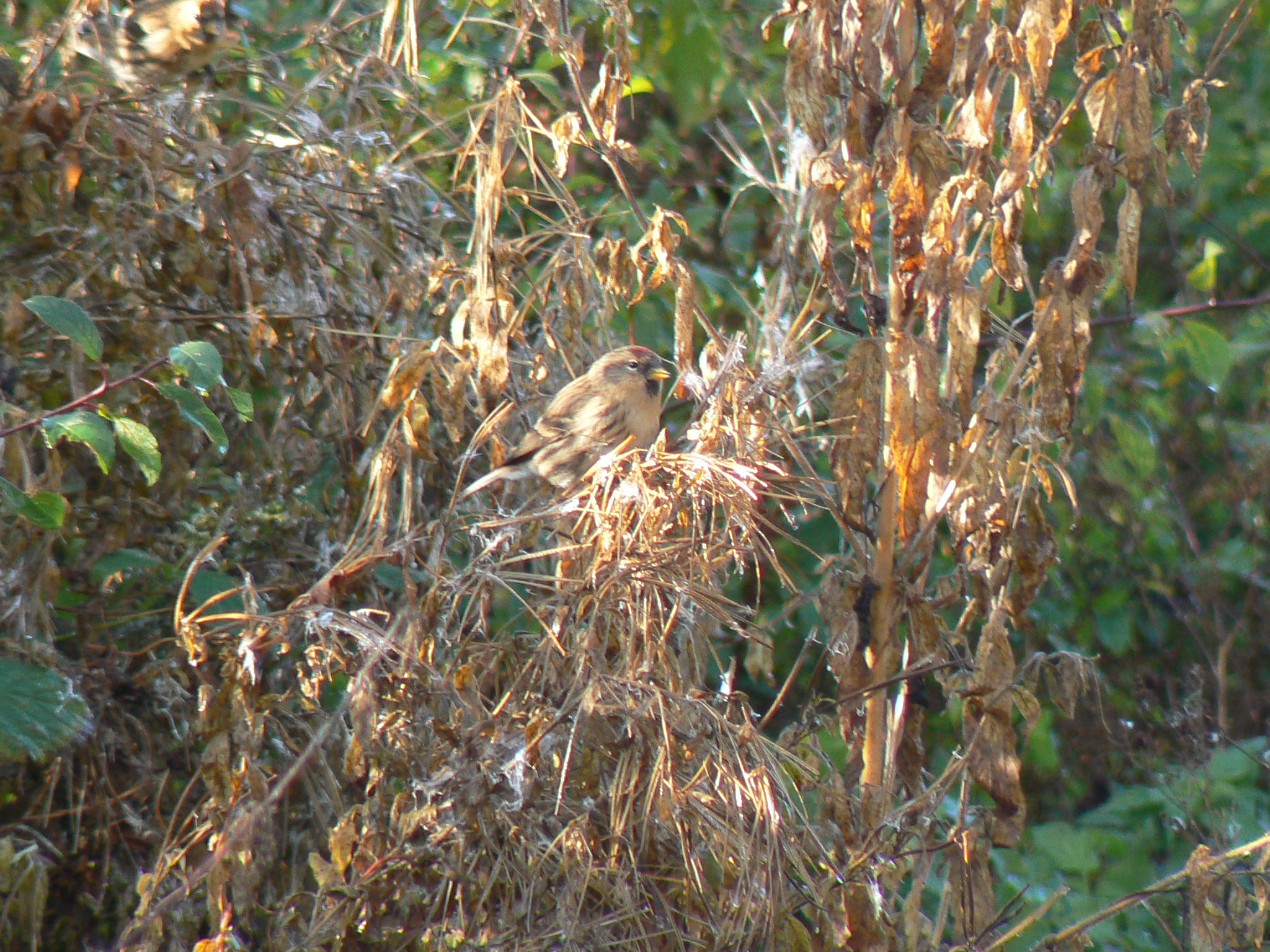
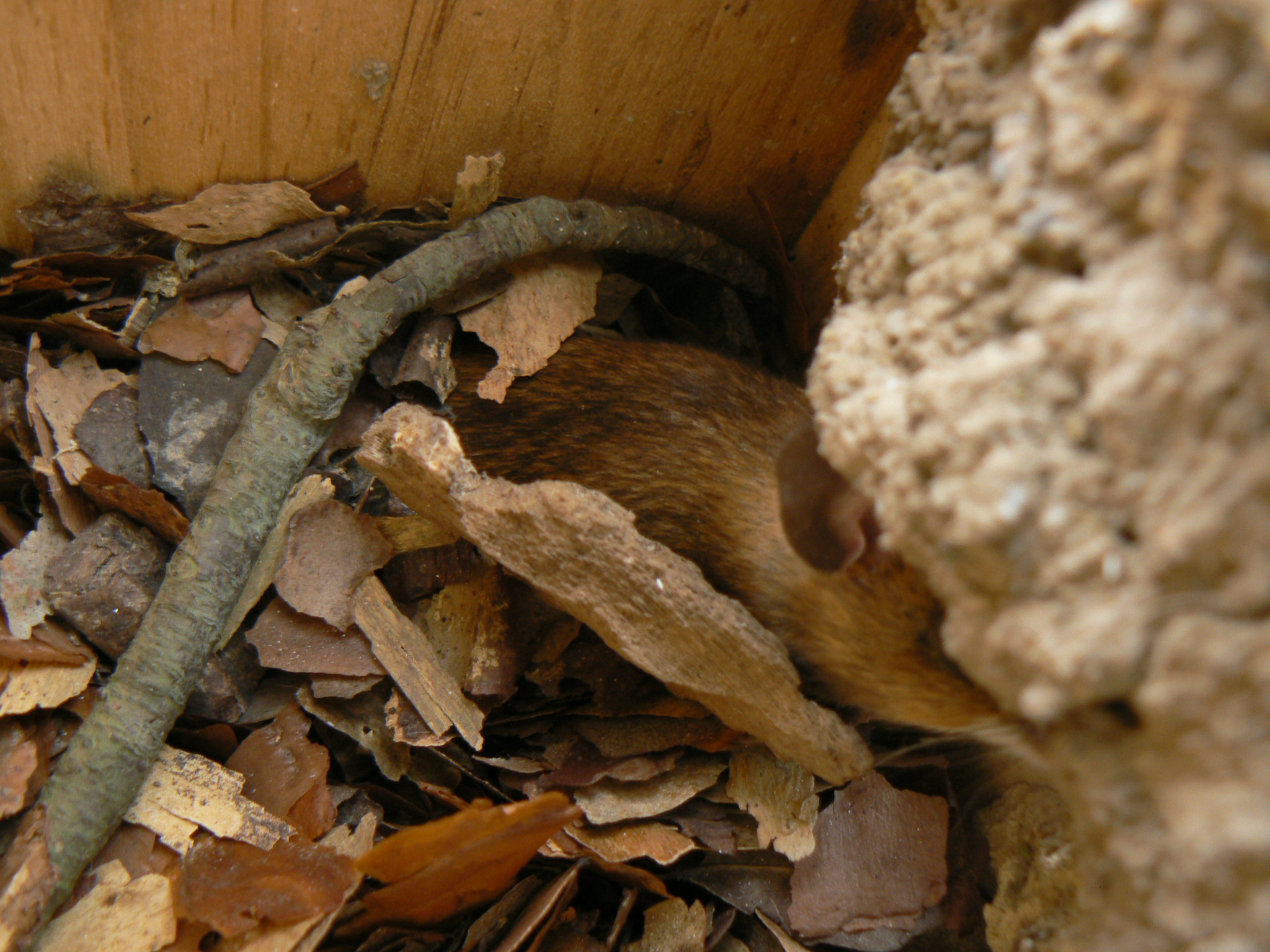
Sunday 4th November - Ray Baker
I took my courage in both hands this morning and went out for a walk around the reserve in between deluges - reasoning being that, whilst birds are pretty tough, they're not stupid, and often won't be very active during the most inclement of weather, so when the rain does stop, they will often come out in some numbers - and so it proved today!
Most notable thing was the number of Blackbirds. Fearing waterlogging, I'd left my notebook at home, but reckon I must have seen 25-30 Blackbirds.... These will mainly be migrants coming over from continental Europe to enjoy our milder maritime climate. I didn't see him today, but it will be interesting to see whether the Blackbird with the white head turns up again this year. Birds can be very site-faithful - my sister-in-law had a rather peculiar caramel-coloured male Blackbird that used to turn up in her garden for a number of winters!
On the theme of thrushes, I also saw 2 Song Thrushes, 2 Redwings and heard a group of Fieldfares calling from a tall oak tree - this is evidence that the winter thrushes are now here in some numbers, as this is far more than I have seen on any other walks in recent months.
I didn't count species, but I would guess at somewhere around the 25-30 mark (which is pretty good for a 30min walk!) and other notables were: Coal Tit in one of the conifers by the quiet garden, Green Woodpecker feeding in the wildflower meadow - nearly got close enough for a photo, flock of Goldfinches feeding down by Derek Slade spinney, but no Redpolls or Siskins with them today, and a Nuthatch in the orchard.
Best sighting though was of 2 Treecreepers on one of the tall oaks that form the boundary of the reserve up by the orchard - this was the same tree that Tom and I saw them in last weekend. It is also the same tree that we saw a rather strange nest in one of the boxes - being a neat cup of interwoven grasses that I hadn't seen before. This baffled me a little bit, as the hole in the nestbox was Tit-sized and hadn't been enlarged, so clearly the box had been used by a small bird, but I couldn't think what it was. Seeing the Treecreepers again today, I started to put 2+2 together, googled what a Treecreeper nest looks like, and am now pretty sure that's what used our nestbox! A great success!!!
In general reserve-news, it was a case of water everywhere. We are now the proud possessors of not 1, but 2 streams.... Since the hedge-laying, the ditch by the side of Jenner's Field seems to be a good deal clearer, and there was quite a torrent going down there this morning. The other river was flowing through the middle of Coldharbour Copse, where the water was draining off of Beacon Field, through the copse and down to join the already inundated W5 ditch. Much more of this and the drought will be over!
One of the many Blackbirds in the reserve this morning, taking advantage of the stakes in the newly-laid hedge, which make excellent lookout posts!
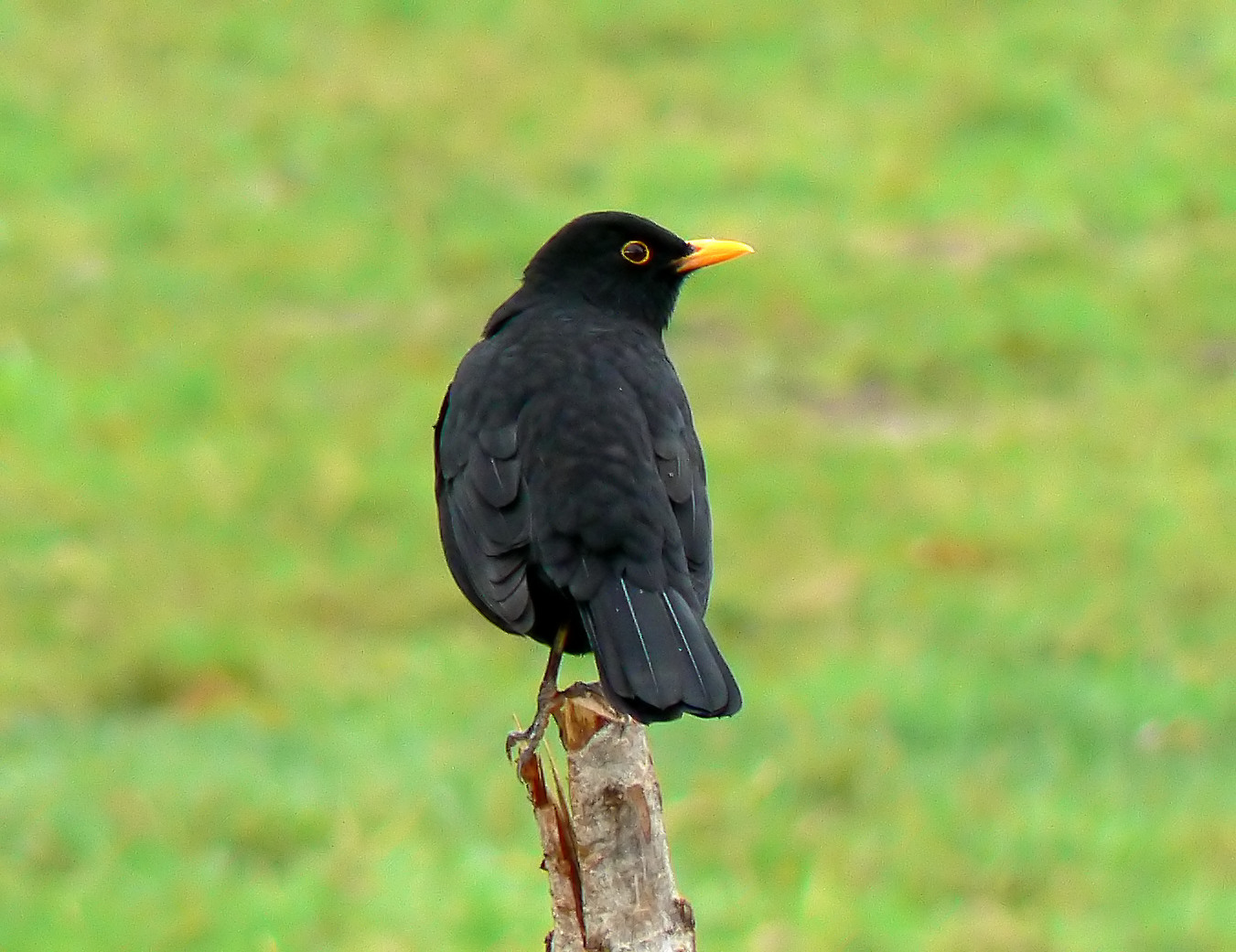
Sunday 28th October - Ray Baker
Order of the day today was to carry out a survey of the birdboxes that we had erected around the reserve in early 2011 to try to find out what had used them this year, and I was lucky to have an able helper in Tom Cartledge, who has been doing quite a bit of work around the reserve in recent weeks as part of his Duke of Edinburgh award - very laudable!
Of the 23 that we had originally put up, 2 had gone missing and 1 had been so badly attacked by either a Woodpecker or possibly Squirrel as to be probably unusable, so we were down to 20, and we were very pleased to see that all but 3 had been used this year - which is a good improvement from last year when we had 8 unused, although this is possibly due to them only being newly erected when the 2011 breeding season got underway.
Not only was the occupancy quite good, but we also could discern that the species using the boxes had varied a bit more from the usual Blue and Great Tits (even though they are the most avid nestbox-using species) If you want to see the full results of our survey, click 'nestboxes' under the 'surveys' tab.
One of our largest boxes had a large nest made of sticks and leaves inside, and I'm still trying to find out what might have used it.... I'm guessing at something like Jackdaw, Collared Dove etc, but a Magpie came and started scolding us as we were clearing it out, but I have never heard of Magpies using boxes before, so this one is currently a mystery.
Another middle-sized box had the entrance hole enlarged to approx 5cm, and on inspection, the inside of the box had 3 patches - one on each internal wall - where the wood had been excavated to a depth of 1cm or so... almost as if a bird had been sitting on the nest and practicing its excavation technique on the box. I'm thinking that only a Greater Spotted Woodpecker would have the power to do this, so very good proof that we have this species breeding in the reserve.
We were delighted to be able to see Nuthatches using one of the nestboxes in the Spring, and by virtue of their habit of using mud to tailor the entrance hole to their liking, I was able to demonstrate this to Tom. I also mentioned that Nuthatches use bark chips as nest material, rather than the usual moss etc, so Tom stuck his hand in the box to have a look, and promptly pulled out a mouse! Not sure what species this might be, with Dormouse, Wood Mouse and Yellow-necked Mouse being mentioned as possible candidates, but no definite information at time of writing. I may go and have another look though, as there was a 2nd mouse in the box that we left well alone. Whatever species it was, it was quite a good climber, as the nestbox was approx 5m up the tree!
All in all, we were very pleased with our morning's work and pleased that the boxes seemed to be finding favour.
In other sightings, we saw and heard 2 Goldcrests -one by the Community Orchard twitten, and one in Coldharbour Copse - neither being places that I usually see this species, but very much in keeping with my more general experiences, as there does seem to be an awful lot of Goldcrests around at the moment. Maybe a good time to find a Firecrest! We were also pleased to see a Treecreeper in the large oaks bordering the orchard - a species that is quite unusual for the reserve, so a good sighting!
Goldcrest Treecreeper
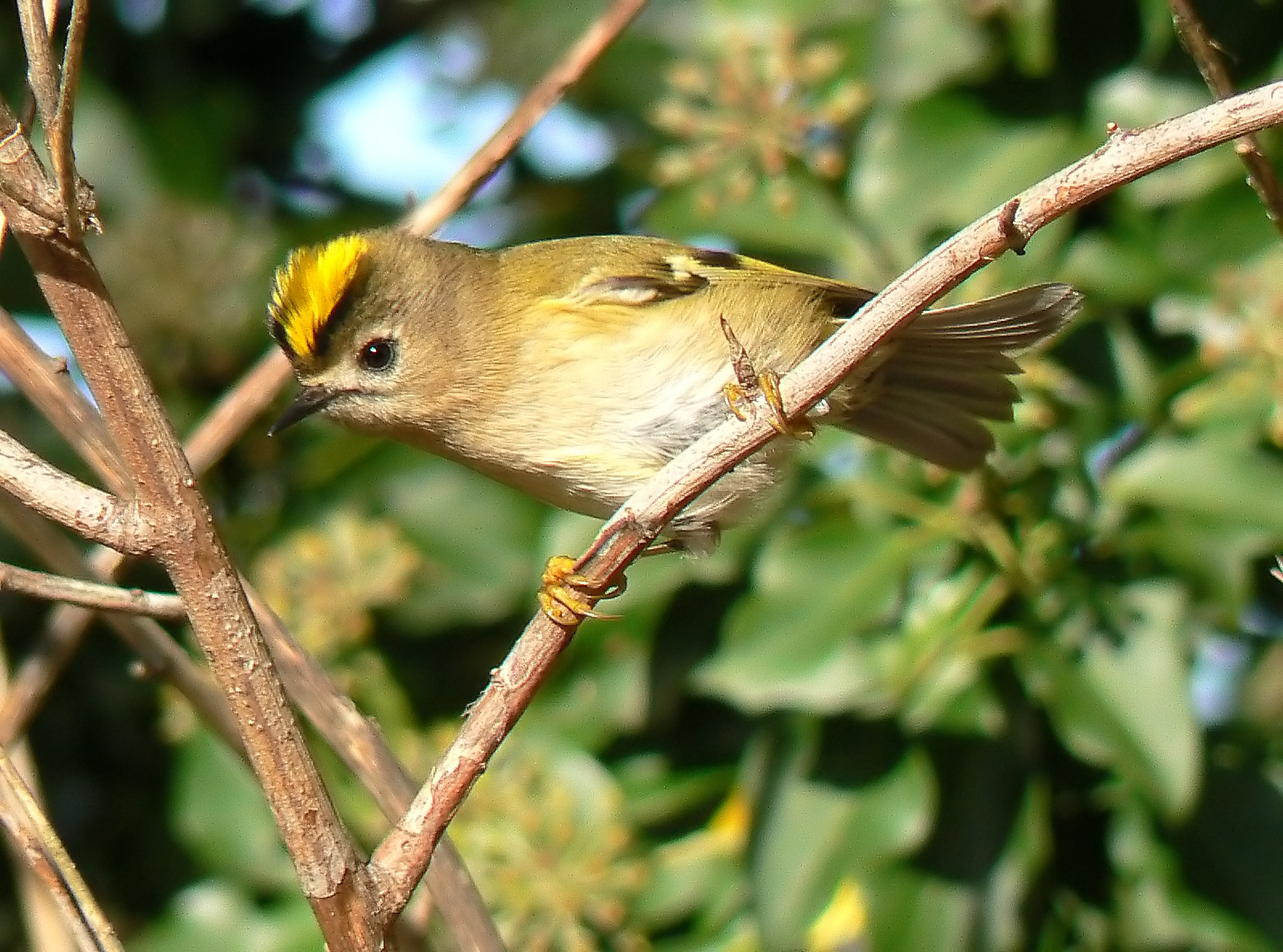
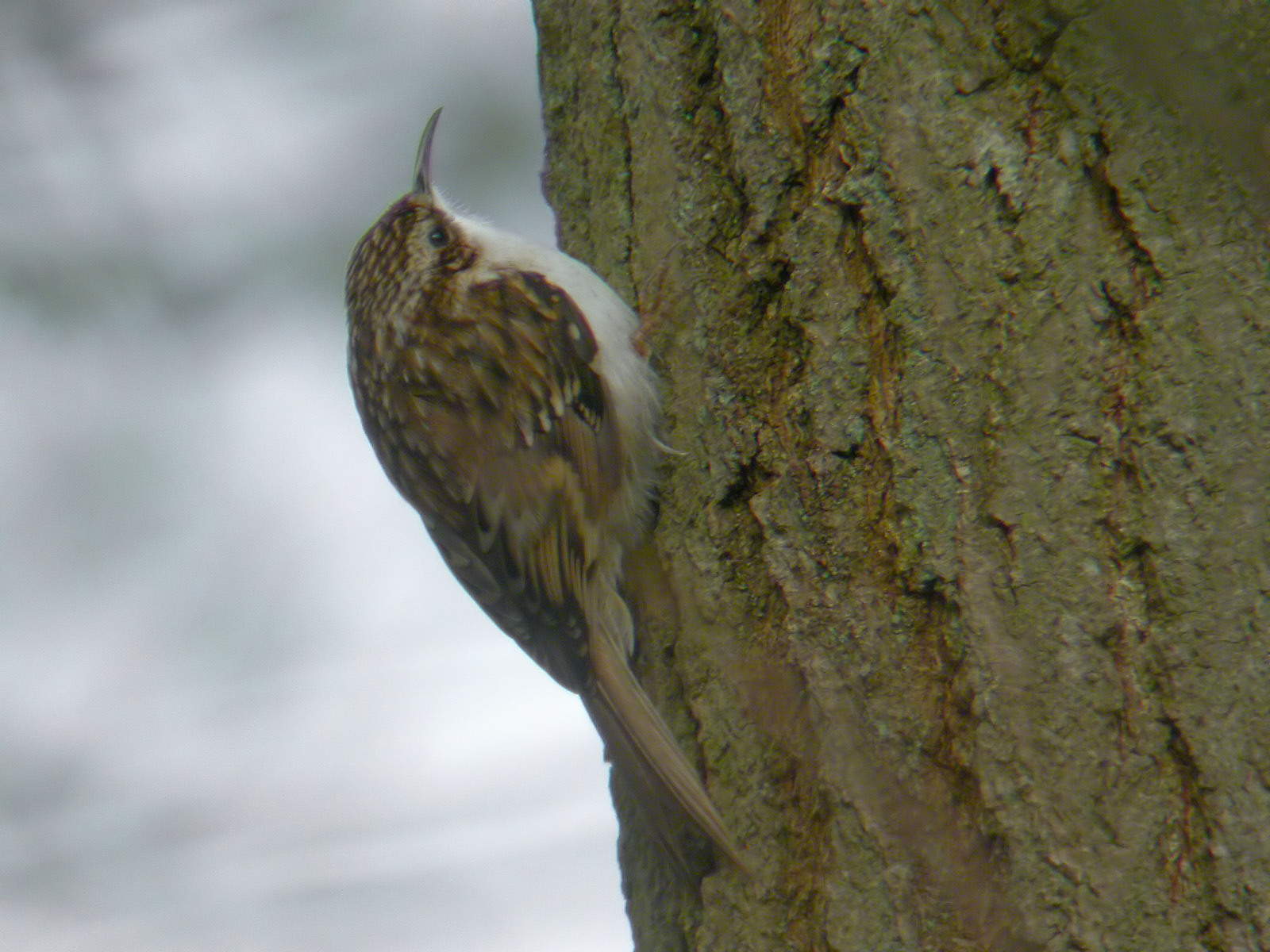
Friday 26th October - Ray Baker
Just a quick trip around the reserve today is the gloom and steady rain, but did see a few interesting things....
One of the typical birding experiences of the winter-time is that tits and other small birds start to form together in large flocks - this make feeding more efficient - and just this week I have seen several of these large flocks. The one in the reserve today was in the large oaks alongside the twitten that form the boundary of the community orchard, and was slightly remarkable in that it seemed to be made up entirely of Blue Tits. Have to say that peering up into a wet, blowy tree, looking for small birds amongst the leaves, is not the easiest of birding duties, so I could easily have missed a few things - it is far more usual for such flocks to contain other species such as Long-tailed and Great Tits, was well as Nuthatch, Treecreeper and Goldcrest to name but 3.
Down by the pond, I had my first definite sighting of the autumn of Redpoll. I have seen a few likely fly-overs, but this was the first confirmed sighting and there were 2 birds feeding together with Goldfinches. You can often be alerted to this species by their call, which always put me in mind of a squeaky gate!
There were quite a few birds moving through over head, with many small groups of Woodpigeons, various corvids and a group of 5 Herring Gulls. These are the archetypal birds that you see at the sea-side, and the ones that love nothing better than to steal your chips and the ice-creams of unwary children. They are also quite large when seen up-close, but these 5 were flying at reasonable height.
Talking of large birds.... I was out walking around the Dormansland area a couple of days ago, and saw 3 Ravens. These birds were pretty-much unknown around these parts until a year or so ago, but there have been several sightings, so it seems likely that they are expanding their range - possibly from the west, but maybe from Ashdown Forest, where the species has been established for several years. As I say, they are large birds (wing-span of 4ft or so!) so range over quite an area, so definitely worth keeping an eye out over the reserve and village. They are all black corvids, and can best be separated from the smaller Crows and Rooks by their tail-shape, which is like a diamond-shaped wedge. They also tend to call a lot, which is most usually a loud Kronk, Kronk.
Another first for me today, was first sighting of the autumn of Fieldfares, with a flock of 30 or so heading over westwards. This is one of the key indicators that winter is one its way, and this attractive thrush has been a bit late in arriving this year, but we should start to see more and more of them now. My 'bird of the week' this week will be the Fieldfare.
Herring Gull Redpoll
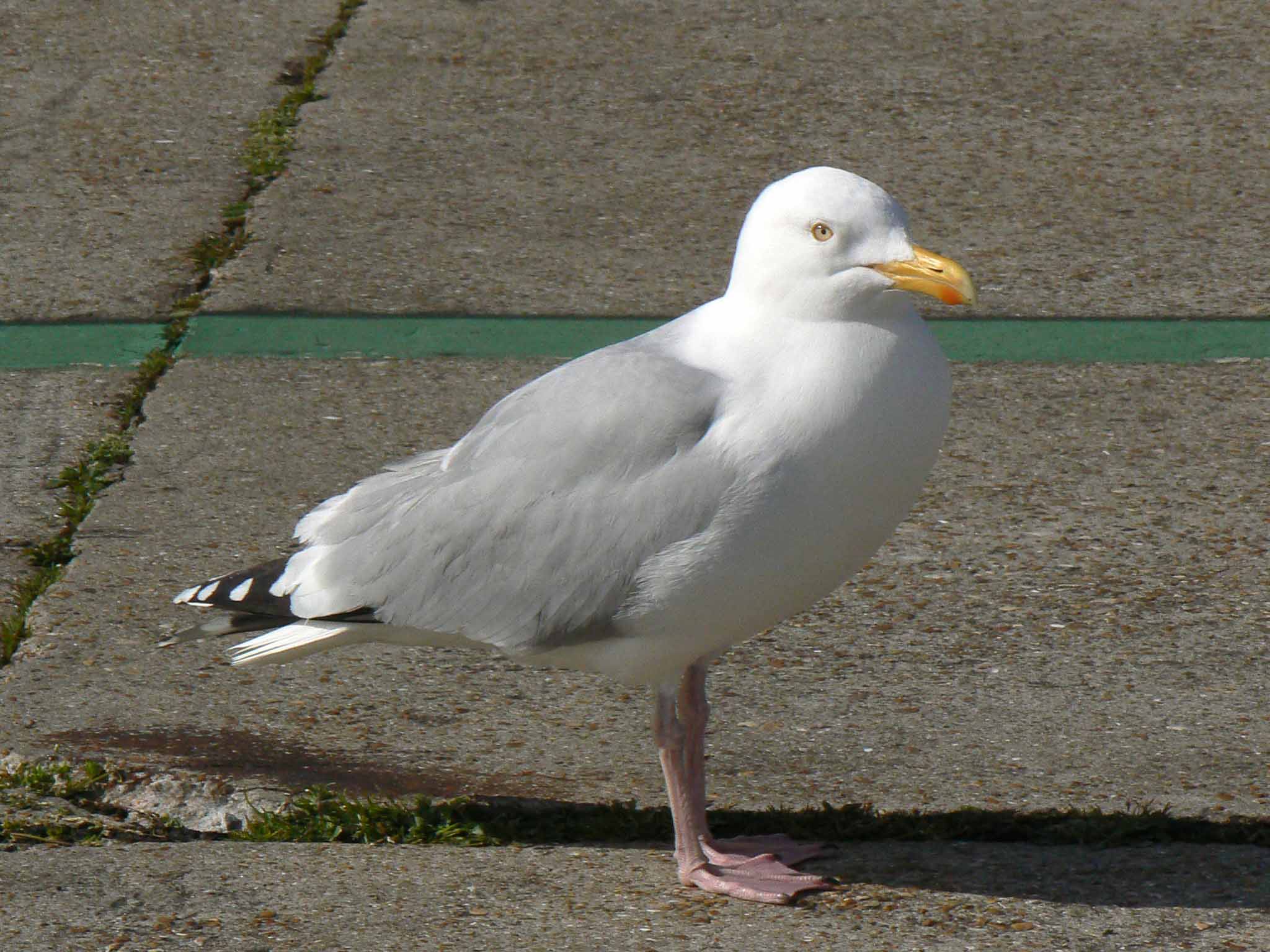
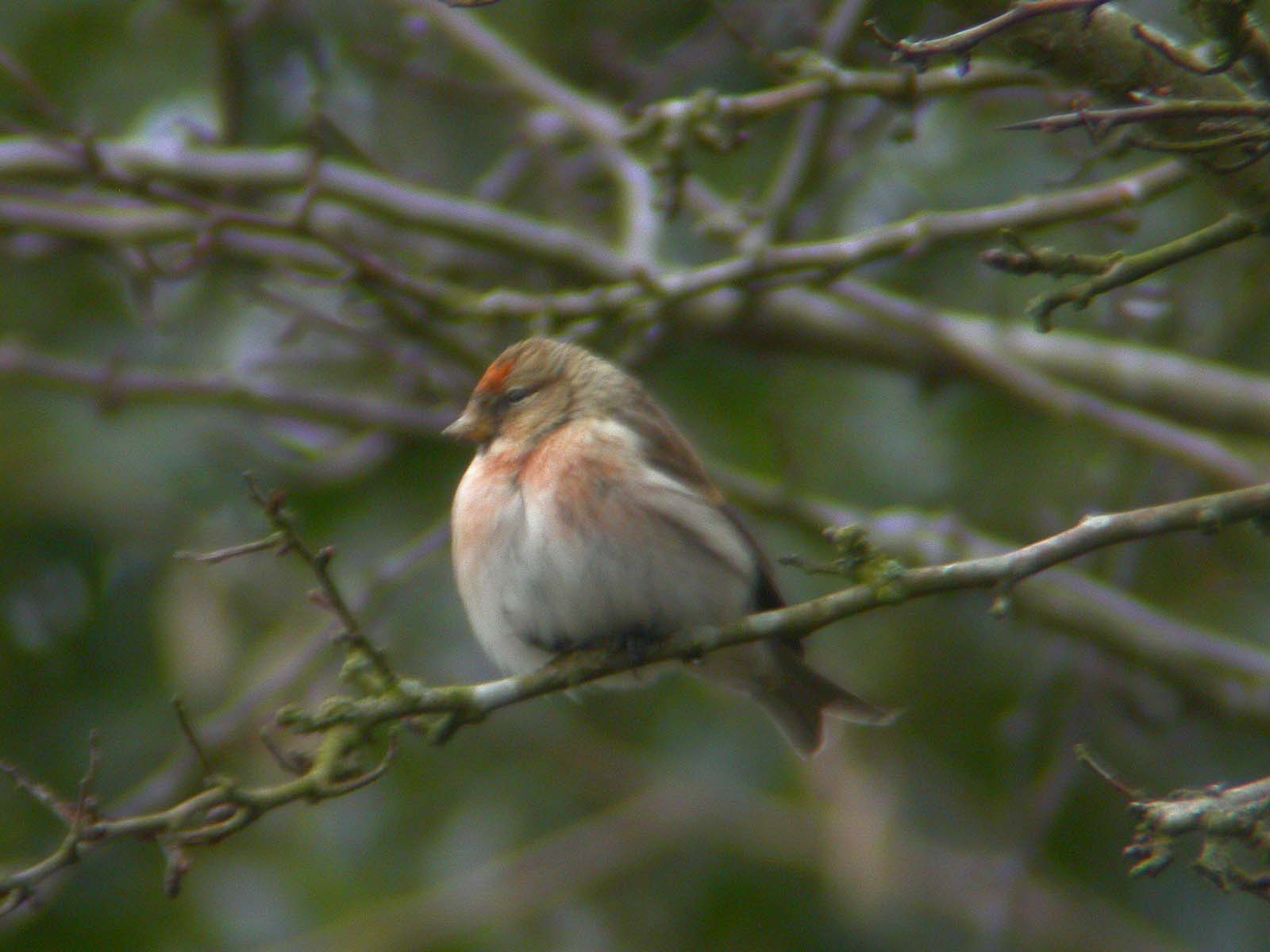
Sunday 21st October - Ray Baker
Not much to be seen on a quick trip around the reserve today...
There was a Greater Spotted Woodpecker feeding in one of the large trees in the orchard - it was given away by the periodic tapping as it searched for food in the bark. This intermittent banging is very different from the full drumming that they do to establish a territory and attract a mate, but you need to be careful, as both Nuthatches and even Great Tits will sometimes knock on the bark of trees, but the GSW makes a much louder noise than either of the other 2 species.
Talking of woodpeckers (I) I recall that I was once watching Black Woodpeckers peel away chunks of bark from a pine tree to search for insects underneath, and later on I went up for a closer look, and was quite surprised to find that each piece was about the size of a tea-plate, which gives some indication of the power of these Crow-sized birds!
Talking of Woodpeckers (II) During the second part of the hedge-laying yesterday we had several instances of sightings and calls of Green Woodpeckers - they are obviously doing quite well in the area.
Back to the reserve.... There were several Magpies around, and a number of Black-headed Gulls went over - I think they are moving around the country quite a bit at the moment, presumably in search of fields that are being ploughed or maybe rubbish tips.
Three small birds went over and I heard a very faint call, which makes me think that they were probably Redpolls, which are one of the species that we are expecting there to be a lot of in the UK this winter, as they have been driven from farther north by lack of food.
I walked part of my assigned route for the thrush-survey (didn't see any thrushes) but thought I would mention that a few of us were remarking about the lack of Song Thrushes, and one chap told us that a well-known local birder was of the opinion that there are actually zero Song Thrushes in the county at this time of year - although I'm still trying to find out where he thought that they might all go to! They will be re-appearing soon though, as the colder weather brings them out, and the numbers of our UK birds are swollen by continental visitors.
Pond water-levels are pretty high, and water is flowing from the top pond down to the main pond via the 2 scrapes. The water is clearing nicely, but not nicely enough for me to be able to find our 'Danger - Deep Water' sign, which some kind soul has ripped from its post and no doubt thrown into the pond!
Sunday 7th October - Ray Baker
I don't know if anyone else has noticed, but there are an awful lot of Red Admiral butterflies about at the moment, and we had one flying around in the community orchard today. The reason that they are more visible in the autumn is that it is migration season, and they are filtering through the S of England on their way to the coast, across the channel, and then onwards to southern Europe and N Africa, where they will spend the winter. It is amazing to think that such delicate creatures can undertake such a journey of thousands of miles (each way) every year, but they do.
Next spring the adults, which have already mated, will arrive back in the UK to lay eggs which will form the basis of the next generation and the whole cycle will start again.
If the fine weather persists, it may still be possible to see Red Admirals into next month as they pass through, and a few sometimes try to over-winter in the UK, but without much success from what I can gather.
It is interesting to compare the Red Admiral with another butterfly that reaches us via migration - the Painted Lady..... Whereas numbers of the Red Admiral are reasonable and fairly consistent each year, the Painted Lady is quite rare in the UK most years, but arrives in this country in their millions in so-called 'Painted Lady' years. What seems to trigger these is a successful breeding year in their over-wintering grounds of Morocco and then favourable migration conditions that allow them to make the final leg of their journey across the channel to reach the UK.
I can well remember being on a camping holiday in Norfolk and seeing virtually every suitable flowering plant festooned with half-a-dozen Painted Ladies.
The good thing about Painted Lady years is that they are predictable, as butterfly watchers in Africa and Spain can see vast numbers of them coming our way, so you can get an alert as to when you should start looking. The last such year was 2009, so we should be due one fairly soon - this species has only been recorded on the reserve in such years, although a few individuals do make it to the UK most years, but are usually only seen on the coast. I did see one individual this summer - on Reigate common - but it was so faded and worn as to be almost unrecognisable.... obviously it had led an interesting life!
Red Admiral Painted Lady
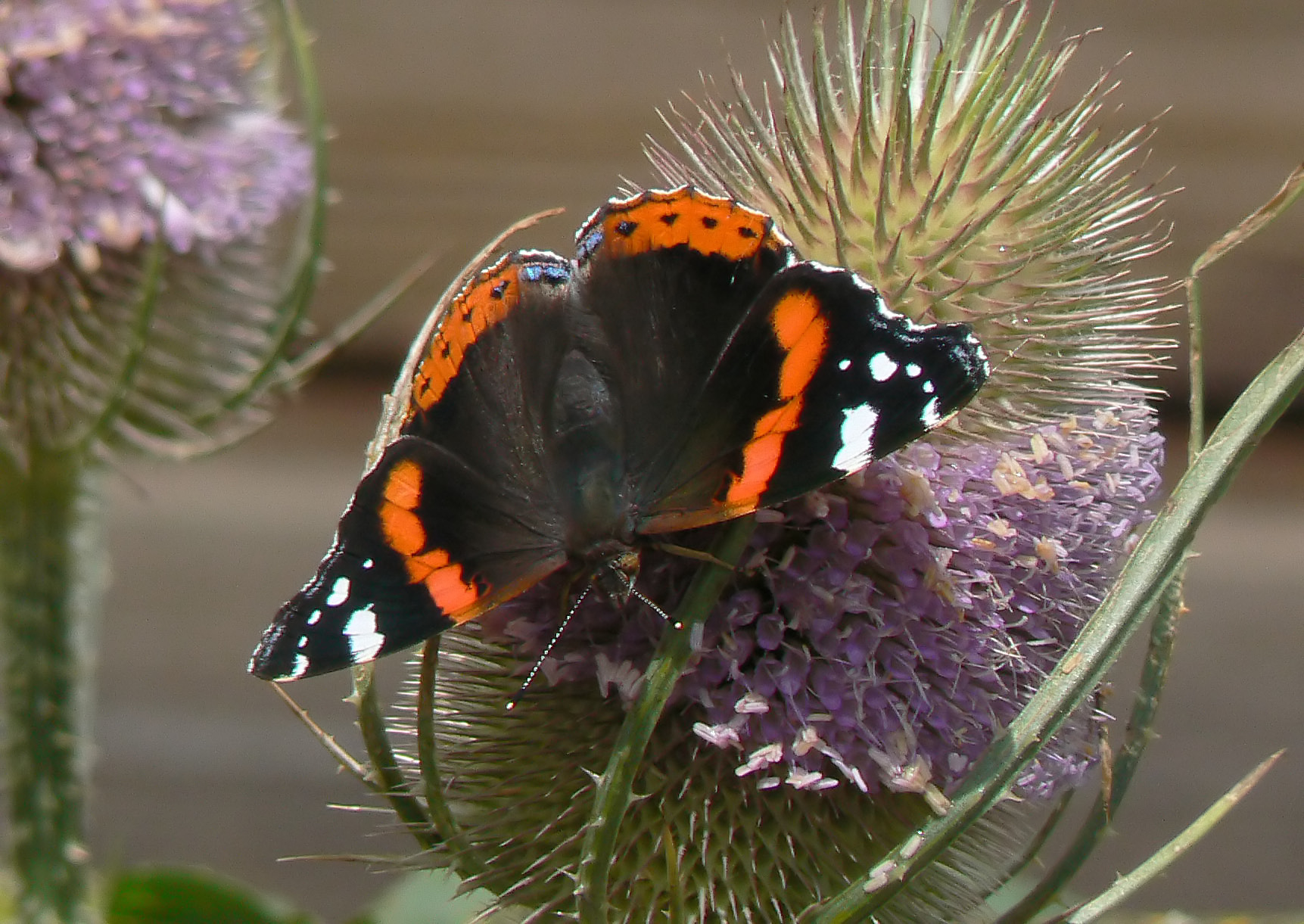
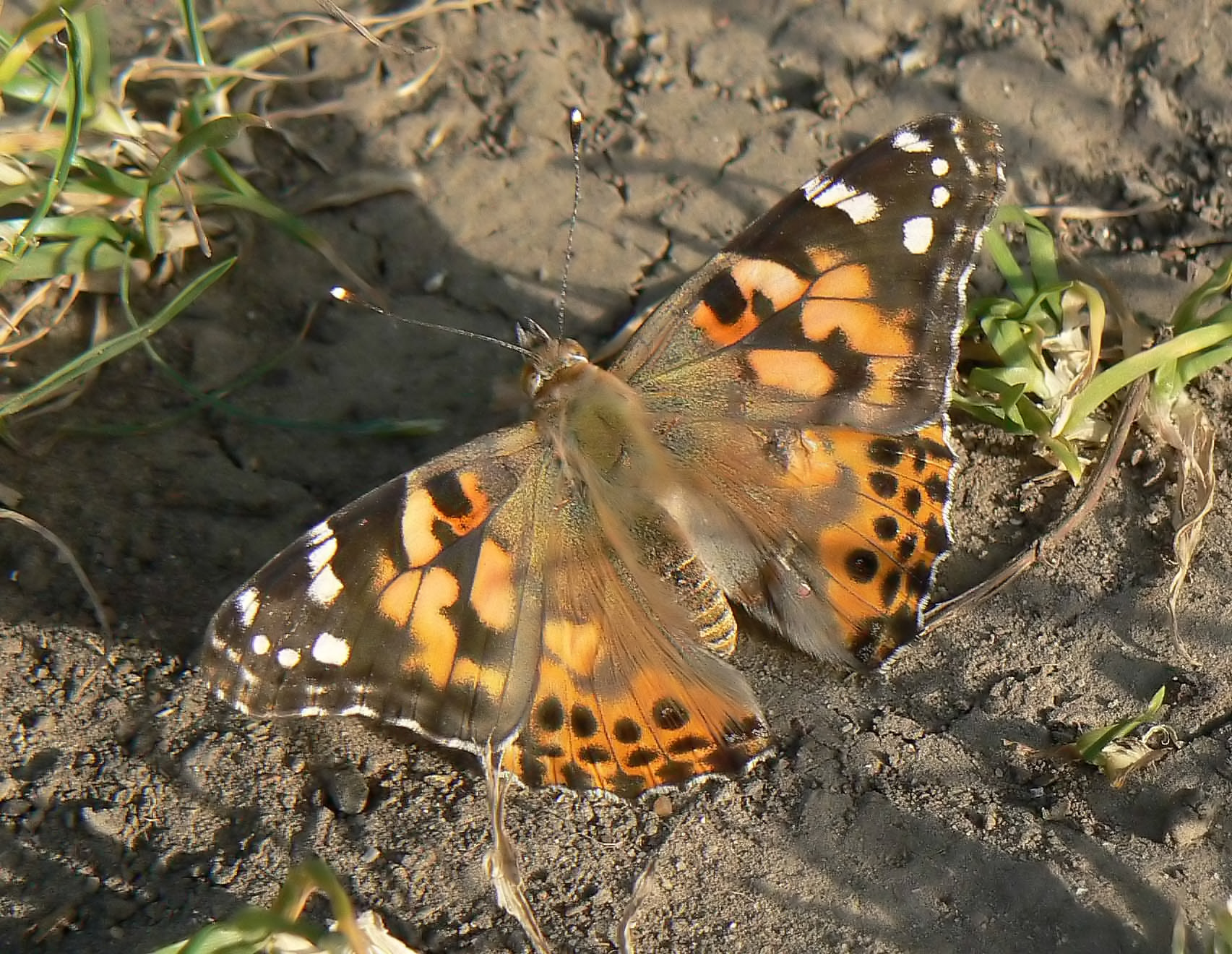
Monday 1st October - Ray Baker
Not so much 'sightings' as 'lack of..', but has anyone else noticed that there aren't any acorns this year? ...or at least there aren't anywhere that I've looked. There are a couple of large oaks in the twitten near to where I live, and so we usually get quite a few acorns blown over into our gardens, but this year, none at all. This got me thinking, and I have been keeping an eye out when out and about in the general area, and I am yet to see any acorns at all.
Intrigued, I turned to the internet and googled acorn shortages etc, and it appears that a similar situation occurred in the eastern states of the USA last year - this did not seem to be within the usual variation of good and bad years, but a total failure of all acorns across large swathes of the countryside.
Disappointingly, I wasn't able to find anything that sounded like a well-thought-out, scientific explanation, but the majority of media and public comment was blaming poor spring weather, not necessarily for the same year, as some people opined that acorns are actually a 2 year production cycle, so not really a great deal of help.
There was quite a lot of comment regarding the effects this was having on other wildlife, with squirrels and other rodents being badly hit by this lack of their usual food, with tales of squirrels coming into people's property and stealing their halloween pumpkins and deer decimating gardens. Another unexpected result is that dog-owners had a terrible time with ticks, which had deserted their normal rodent hosts to make a new home on Fido!
As rgds here in the UK, the most obvious species that might struggle with this are Jays, who spend much of the autumn gathering acorns to bury in caches for later consumption - I wonder how they will get on finding alternative ways of making a living.
Enough of what I didn't see.... Again not so many small birds, just a few tits, sparrows and I heard a Bullfinch calling down by the pond, but did see lots of larger birds again, with Crows, Jays and Magpies being numerous, and another sighting of the Green Woodpecker in Bloomer's field. I had a quick look in the ponds (filling up again!) and this time did see a couple of tiny newt larvae in the gin-clear water of the upper pond.
